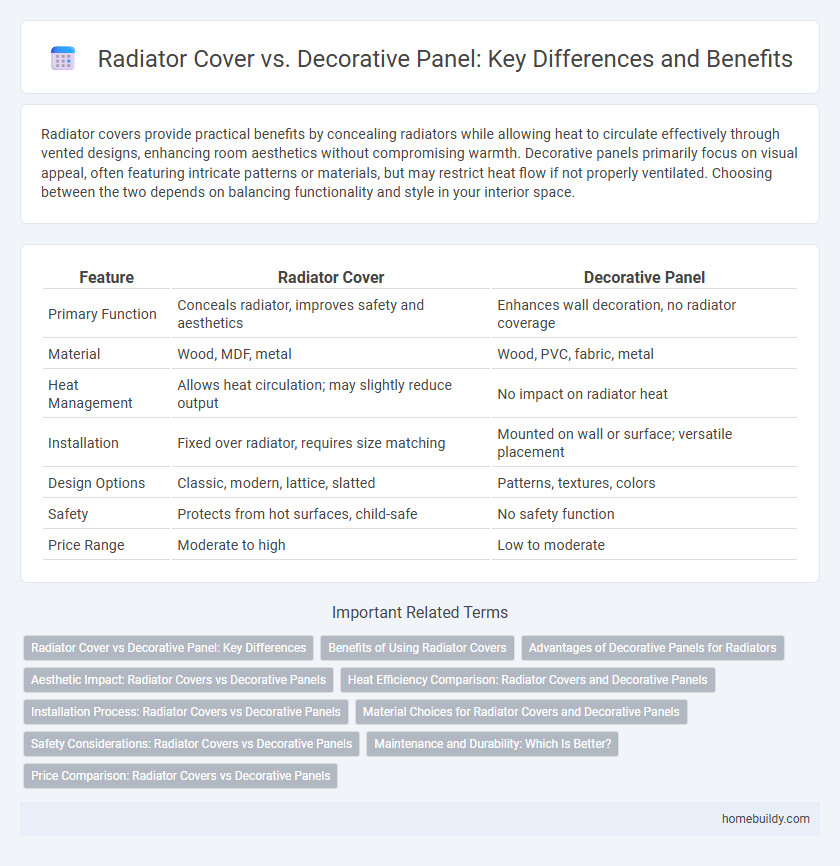Radiator covers provide practical benefits by concealing radiators while allowing heat to circulate effectively through vented designs, enhancing room aesthetics without compromising warmth. Decorative panels primarily focus on visual appeal, often featuring intricate patterns or materials, but may restrict heat flow if not properly ventilated. Choosing between the two depends on balancing functionality and style in your interior space.
Table of Comparison
| Feature | Radiator Cover | Decorative Panel |
|---|---|---|
| Primary Function | Conceals radiator, improves safety and aesthetics | Enhances wall decoration, no radiator coverage |
| Material | Wood, MDF, metal | Wood, PVC, fabric, metal |
| Heat Management | Allows heat circulation; may slightly reduce output | No impact on radiator heat |
| Installation | Fixed over radiator, requires size matching | Mounted on wall or surface; versatile placement |
| Design Options | Classic, modern, lattice, slatted | Patterns, textures, colors |
| Safety | Protects from hot surfaces, child-safe | No safety function |
| Price Range | Moderate to high | Low to moderate |
Radiator Cover vs Decorative Panel: Key Differences
Radiator covers are specifically designed to enclose and protect radiators, improving safety and heat distribution, while decorative panels primarily serve aesthetic purposes without significantly affecting warmth or safety. Radiator covers often feature slatted designs to allow efficient airflow, whereas decorative panels may block heat if placed directly over the radiator. Choosing a radiator cover enhances both functionality and visual appeal, whereas decorative panels may only enhance room decor without offering practical radiator benefits.
Benefits of Using Radiator Covers
Radiator covers offer enhanced safety by preventing direct contact with hot surfaces, reducing the risk of burns, especially in homes with children or pets. They optimize heat distribution through carefully designed panels, improving room warmth without obstructing airflow. Unlike simple decorative panels, radiator covers provide added storage or shelving options, combining functionality with aesthetic appeal.
Advantages of Decorative Panels for Radiators
Decorative panels for radiators provide enhanced airflow compared to traditional radiator covers, improving heating efficiency while maintaining aesthetic appeal. These panels offer customizable designs that seamlessly integrate with interior decor without bulk, allowing for better space utilization. Their lightweight materials facilitate easy installation and maintenance, making them a practical choice for modern heating solutions.
Aesthetic Impact: Radiator Covers vs Decorative Panels
Radiator covers provide a three-dimensional aesthetic impact by enclosing the radiator's bulk while allowing heat to circulate effectively, creating a unified and polished look in any room. Decorative panels, though visually appealing, often lack depth and do not conceal the radiator's structural elements, resulting in a flatter and less integrated appearance. Choosing a radiator cover enhances both functionality and style by blending heat efficiency with sophisticated design, whereas decorative panels serve primarily as surface-level embellishments.
Heat Efficiency Comparison: Radiator Covers and Decorative Panels
Radiator covers are specifically designed to enhance heat distribution by allowing warm air to circulate efficiently through vents and perforations, whereas decorative panels often restrict airflow, reducing overall heat output. Materials used in radiator covers, such as metal or heat-resistant wood, improve thermal conductivity compared to typical decorative panels, which prioritize aesthetics over function. Consequently, radiator covers maintain better heat efficiency, preventing energy loss and promoting a warmer indoor environment.
Installation Process: Radiator Covers vs Decorative Panels
Radiator covers typically require basic assembly and securing around the radiator, often involving screws and brackets to ensure proper ventilation and safety. Decorative panels usually offer simpler installation, involving adhesive strips or mounting hooks, making them a quick, non-invasive option. Proper installation of radiator covers prioritizes heat efficiency and protection, whereas decorative panels focus more on aesthetic enhancement with minimal structural adjustments.
Material Choices for Radiator Covers and Decorative Panels
Radiator covers are typically made from durable materials like MDF, wood, or metal to withstand heat and provide protection, while decorative panels often use lighter materials such as PVC, acrylic, or fabric for aesthetic enhancement. MDF and wood offer strength and heat resistance essential for radiator covers, whereas PVC and acrylic panels prioritize design versatility and ease of installation. Metal radiator covers combine durability with heat tolerance, making them suitable for high-temperature environments compared to decorative panels focused mainly on visual appeal.
Safety Considerations: Radiator Covers vs Decorative Panels
Radiator covers provide enhanced safety by enclosing the radiator completely, reducing the risk of burns and protecting children and pets from direct contact with hot surfaces. Decorative panels may improve aesthetics but often lack the full protective barrier that radiator covers offer, leaving gaps where accidental contact can occur. Choosing a radiator cover with heat-resistant materials ensures maximum safety without compromising airflow and heating efficiency.
Maintenance and Durability: Which Is Better?
Radiator covers typically offer enhanced durability due to their robust construction designed to withstand heat exposure and regular handling, while decorative panels may prioritize aesthetic appeal over longevity. Maintenance for radiator covers is generally easier because their materials resist staining and can be cleaned with simple wipes, whereas decorative panels might require delicate care to preserve finishes and intricate designs. Choosing between the two depends on prioritizing long-term durability and low-maintenance needs over purely decorative functions.
Price Comparison: Radiator Covers vs Decorative Panels
Radiator covers generally cost more than decorative panels due to their functional design that requires ventilation and heat resistance materials. Decorative panels are typically cheaper, focusing primarily on aesthetics without the need for heat management features. The price difference reflects the added complexity and safety standards involved in manufacturing radiator covers.
Radiator cover vs Decorative panel Infographic

 homebuildy.com
homebuildy.com